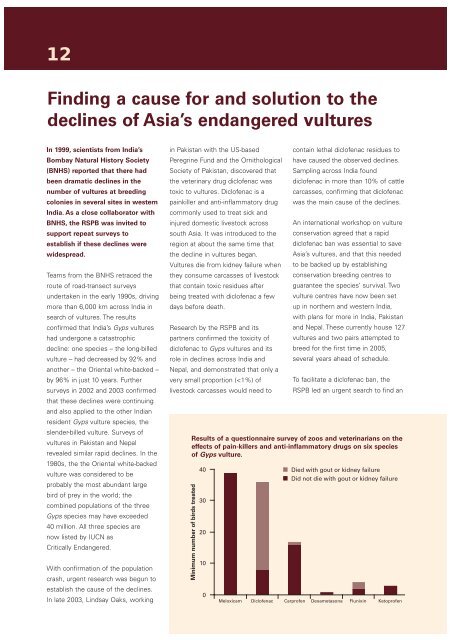Conservation Science in the RSPB 2006
Conservation Science in the RSPB 2006
Conservation Science in the RSPB 2006
You also want an ePaper? Increase the reach of your titles
YUMPU automatically turns print PDFs into web optimized ePapers that Google loves.
12<br />
F<strong>in</strong>d<strong>in</strong>g a cause for and solution to <strong>the</strong><br />
decl<strong>in</strong>es of Asia’s endangered vultures<br />
In 1999, scientists from India’s<br />
Bombay Natural History Society<br />
(BNHS) reported that <strong>the</strong>re had<br />
been dramatic decl<strong>in</strong>es <strong>in</strong> <strong>the</strong><br />
number of vultures at breed<strong>in</strong>g<br />
colonies <strong>in</strong> several sites <strong>in</strong> western<br />
India. As a close collaborator with<br />
BNHS, <strong>the</strong> <strong>RSPB</strong> was <strong>in</strong>vited to<br />
support repeat surveys to<br />
establish if <strong>the</strong>se decl<strong>in</strong>es were<br />
widespread.<br />
Teams from <strong>the</strong> BNHS retraced <strong>the</strong><br />
route of road-transect surveys<br />
undertaken <strong>in</strong> <strong>the</strong> early 1990s, driv<strong>in</strong>g<br />
more than 6,000 km across India <strong>in</strong><br />
search of vultures. The results<br />
confirmed that India’s Gyps vultures<br />
had undergone a catastrophic<br />
decl<strong>in</strong>e: one species – <strong>the</strong> long-billed<br />
vulture – had decreased by 92% and<br />
ano<strong>the</strong>r – <strong>the</strong> Oriental white-backed –<br />
by 96% <strong>in</strong> just 10 years. Fur<strong>the</strong>r<br />
surveys <strong>in</strong> 2002 and 2003 confirmed<br />
that <strong>the</strong>se decl<strong>in</strong>es were cont<strong>in</strong>u<strong>in</strong>g<br />
and also applied to <strong>the</strong> o<strong>the</strong>r Indian<br />
resident Gyps vulture species, <strong>the</strong><br />
slender-billed vulture. Surveys of<br />
vultures <strong>in</strong> Pakistan and Nepal<br />
revealed similar rapid decl<strong>in</strong>es. In <strong>the</strong><br />
1980s, <strong>the</strong> <strong>the</strong> Oriental white-backed<br />
vulture was considered to be<br />
probably <strong>the</strong> most abundant large<br />
bird of prey <strong>in</strong> <strong>the</strong> world; <strong>the</strong><br />
comb<strong>in</strong>ed populations of <strong>the</strong> three<br />
Gyps species may have exceeded<br />
40 million. All three species are<br />
now listed by IUCN as<br />
Critically Endangered.<br />
With confirmation of <strong>the</strong> population<br />
crash, urgent research was begun to<br />
establish <strong>the</strong> cause of <strong>the</strong> decl<strong>in</strong>es.<br />
In late 2003, L<strong>in</strong>dsay Oaks, work<strong>in</strong>g<br />
<strong>in</strong> Pakistan with <strong>the</strong> US-based<br />
Peregr<strong>in</strong>e Fund and <strong>the</strong> Ornithological<br />
Society of Pakistan, discovered that<br />
<strong>the</strong> veter<strong>in</strong>ary drug diclofenac was<br />
toxic to vultures. Diclofenac is a<br />
pa<strong>in</strong>killer and anti-<strong>in</strong>flammatory drug<br />
commonly used to treat sick and<br />
<strong>in</strong>jured domestic livestock across<br />
south Asia. It was <strong>in</strong>troduced to <strong>the</strong><br />
region at about <strong>the</strong> same time that<br />
<strong>the</strong> decl<strong>in</strong>e <strong>in</strong> vultures began.<br />
Vultures die from kidney failure when<br />
<strong>the</strong>y consume carcasses of livestock<br />
that conta<strong>in</strong> toxic residues after<br />
be<strong>in</strong>g treated with diclofenac a few<br />
days before death.<br />
Research by <strong>the</strong> <strong>RSPB</strong> and its<br />
partners confirmed <strong>the</strong> toxicity of<br />
diclofenac to Gyps vultures and its<br />
role <strong>in</strong> decl<strong>in</strong>es across India and<br />
Nepal, and demonstrated that only a<br />
very small proportion (

















